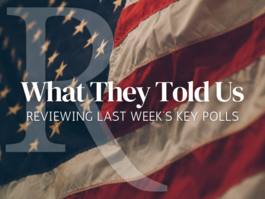Another Impossible Thing May Happen: Change in Partisan Alignments
A Commentary By Michael Barone
In my last column, I looked at the possibility of two impossible things -- impossible things in the sense used by Alice and the Red Queen -- happening in the already turbulent 2016 presidential cycle. Here I'll look at another: the possibility that the partisan division lines that have endured with little change for two decades might suddenly shift and change.
This has happened before. History teaches two lessons pointing in opposite directions: Partisan divisions can stay the same for a long time. And they can change suddenly and without much warning.
There's no question that partisan divisions have shifted little in recent years. Consider the almost precisely identical popular vote percentages for Barack Obama in 2012 (51.01 percent) and those when you combine the 2000 vote for Al Gore and Ralph Nader (48.38 plus 2.74 for 51.12 percent). The Republican percentages in those elections were nearly identical, too: 47.15 percent for Mitt Romney and 47.87 percent for George W. Bush.
The circumstances were similar. Gore was incumbent vice president in an administration with positive job approval; Obama was the incumbent president whose approval reached 50 percent on Election Day. Under different circumstances, the Republican percentage rose a few points higher in 2004 and the Democratic percentage a few points higher in 2008.
Moreover, the national pattern was matched in most states. In 28 states and the District of Columbia the Obama 2012 and Gore/Nader percentages were within 1 or 2 percent (rounded off) of each other.
The biggest shifts were not, by the way, in California, Texas or Florida, despite large Hispanic immigrant influxes. They voted just 1 or 2 points differently in 2000 and 2012, and the same was true for the large states from New York and New Jersey westward to Illinois and Wisconsin, Minnesota and Iowa.
The biggest shift toward Democrats, 9 points, came in Obama's birthplace Hawaii, and in left-trending Vermont. The next biggest (at 5 points) were in Virginia and North Carolina, where the Obama campaign rallied high-education newcomers and larger-than-national-average black populations to the polls.
The biggest shift toward Republicans came in the Appalachian/Jacksonian belt --coal-rich West Virginia (12 points), Clinton's home in Arkansas (10 points) and Gore's in Tennessee (9 points), plus 5 point shifts in Kentucky, Louisiana and Oklahoma. Also, Mitt Romney's home states of Massachusetts and Utah shifted 6 points Republican.
All of which suggests that the 2016 results should look somewhat similar. Neither party has won less than 46 percent or more than 53 percent nationally since 1984. Like economic forecasters, psephologists usually expect the next cycle to look like the last one.
But maybe not. Consider another extended period with even more turmoil during which the two parties' presidential percentages were almost identical at beginning and end: 1960 to 1976. John Kennedy got 49.72 percent of the popular vote, Jimmy Carter 50.08 percent.
Here again, despite the upheaval of the civil rights revolution, there was surprisingly little regional change. The Carter and Kennedy percentages were within 1 or 2 points in 22 states (D.C. didn't vote in 1960).
The biggest shifts toward Democrats were in Arkansas and Tennessee, where the young Clinton and Gore were on the ballot, and in Mississippi, thanks to enfranchisement of blacks by the 1965 Voting Rights Act. The biggest shifts toward Republicans were in Alaska and Utah.
Both 1976 nominees came from their parties' historic heartlands, the Upper Midwest and the Deep South. That helped Carter reassemble a Democratic coalition that looked much like Kennedy's, uniting Northern Catholics and Deep South whites, augmented with blacks. Gerald Ford, like Richard Nixon, carried affluent suburbs and California, even winning 49 percent in the San Francisco Bay Area.
But that 1960-1976 alignment quickly disappeared. Carter lost 12 of 14 Southern states to Ronald Reagan, and the South became bedrock Republican -- presidentially in 1984, congressionally in 1994. Affluent suburbs in million-plus Northern metropolitan areas moved toward Democrats in the 1990s. Mitt Romney got 24 percent in the Bay Area in 2012.
For 2016, Hillary Clinton is trying to re-assemble the Obama majority. Republican strategists are hoping to pluck enough 2012 target states to win. But events so far -- Clinton's slide, the Trump phenomenon -- may destabilize what have been enduring partisan preferences. And who knows what more turbulence is ahead?
Just about every election watcher (including me) has assumed that a new partisan alignment is an impossible thing. History tells us it is -- until it isn't.
Michael Barone, senior political analyst at the Washington Examiner (www.washingtonexaminer.com), where this article first appeared, is a resident fellow at the American Enterprise Institute, a Fox News Channel contributor and a co-author of The Almanac of American Politics. To find out more about Michael Barone, and read features by other Creators writers and cartoonists, visit the Creators Syndicate Web page at www.creators.com.
COPYRIGHT 2015 CREATORS.COM
See Other Political Commentary.
See Other Commentaries by Michael Barone.
Views expressed in this column are those of the author, not those of Rasmussen Reports.
Rasmussen Reports is a media company specializing in the collection, publication and distribution of public opinion information.
We conduct public opinion polls on a variety of topics to inform our audience on events in the news and other topics of interest. To ensure editorial control and independence, we pay for the polls ourselves and generate revenue through the sale of subscriptions, sponsorships, and advertising. Nightly polling on politics, business and lifestyle topics provides the content to update the Rasmussen Reports web site many times each day. If it's in the news, it's in our polls. Additionally, the data drives a daily update newsletter and various media outlets across the country.
Some information, including the Rasmussen Reports daily Presidential Tracking Poll and commentaries are available for free to the general public. Subscriptions are available for $4.95 a month or 34.95 a year that provide subscribers with exclusive access to more than 20 stories per week on upcoming elections, consumer confidence, and issues that affect us all. For those who are really into the numbers, Platinum Members can review demographic crosstabs and a full history of our data.
To learn more about our methodology, click here.



